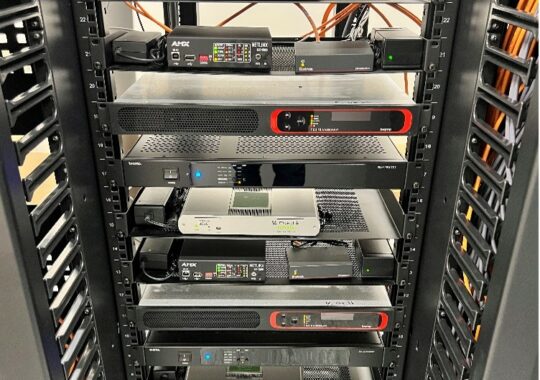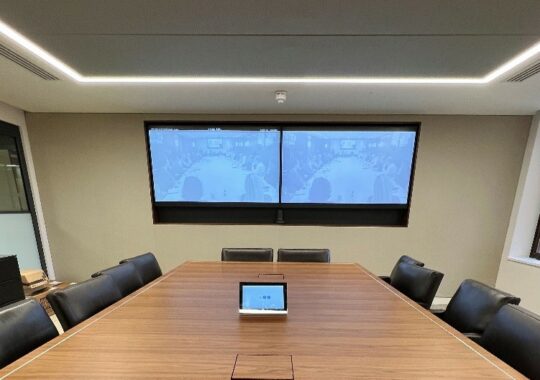Author: Ross Turnbull, Associate, SM&W London
Innovation drives the Audiovisual (AV) industry forward, more so than most. The AV industry has seen exponential developments in Unified Communications, as the majority of workers in 2023 have adopted hybrid or fully remote work environments. One may argue that the industry’s greatest offering to the current environmental crises is the ability to meet and work from anywhere, without the environmental costs this would normally attract.
We ask, is this enough? Has the AV industry contributed all it can to the several environmental crises currently in the spotlight?
The short answer to this is no. The unfavorable answer is that every single component and object in the AV industry is made from a material that is in some way damaging to the planet. The vast majority of products are made from plastic, contain lithium batteries, are facilitated by power-hungry data centers, and are transported across the world via an array of methods. The real question is considering all of these factors, do the AV industry’s contributions to the future of this planet outweigh the environmental costs? If not, as the industry expands and it processes more and more resources, how can it limit its environmental cost and increase its contributions and benefits? How can it reach a point of sustainable practice?
The frequent introduction of new models and features increase the need to replace and upgrade. This isn’t an isolated incident within the Audiovisual industry; it is a constant of the technology industry on both individual and organizational levels. Smartphone models are updated every year – Marketing and social pressure increases demand, whilst shortages in components reduce supply. In many large companies, the cost of disposing of equipment is so high, it is often cheaper to store discarded equipment than it is to recycle it.
Innovation does not need to be limited to the function of the products. Innovation can be expanded to how products are sourced and disposed of. The good news is that we are at the beginning of an innovative revolution in this regard as manufacturers have already begun making strides at this level. During SM&W’s recent visits to exhibitions, we have observed manufacturers placing sustainability and climate change at the heart of their stands and vision to the public. Their offerings are the first step towards large scale change.
While large industrial change may be out of reach for all but the largest manufacturers, and the rest of us may only have the options provided to us by the current ecosystem, we must realize that change starts small, and it starts at home. It begins with auditing yourself and your organization to find where improvements can be made.
If you are at a loss for how you can improve your sustainable practices, then there are several initiatives that you may consider.
Donate old equipment to less fortunate organizations
Several organizations are in the beneficial position of being able to maximize their AV real estate and remain in line with current trends. Sometimes this is a necessity to maintain a technological or competitive advantage. This can lead to increased waste output, with large format displays, and UC equipment being disposed of in large quantities. This mostly finds its way into recycling schemes, or spare stock, but it would be prudent to think of the smaller organizations (such as schools and colleges) whose stretched budgets rarely meet the requirement for technology, particularly AV/UC. In my personal experience, I have witnessed schools and universities that still use VGA and composite video, whilst hordes of perfectly good and functional equipment are being discarded by large companies during AV refreshes. Next time you are upgrading an AV system, simply consider alternatives to standard recycling and disposal. Several organizations facilitate this. Some are only a quick search away, and even collect it from you.
Shift our selection of equipment to its reliability in addition to current metrics
There are many manufacturers offering entry level equipment and more cost-effective products, but it is often that these come with limited warranty, shorter operating hours and are less efficient in their power consumption. When designing audiovisual spaces and technological refreshes, it is important to look beyond the immediate end to the project and the initial budget. If possible, consider the benefits of what a small increase in budget could provide (i.e Displays warrantied to 24/7 use with the ability to provide Eco-friendly operation or energy-rated amplifiers). These advantages come at a cost, but extended ownership of a percentage of your AV real estate can reduce the need to replace products as often, which may create unnecessary waste through repairs and returns.
Include a company’s sustainable offerings in your product selection criteria.
Many manufacturers are now seriously considering sustainability when planning their offerings. Whether that is through recycling products or creating new products from recycled materials, the efforts of these manufacturers are usually well documented. In AV, a manufacturer’s environmental impact has rarely been a factor in product selection, as designers typically reward innovation and extended features. However, if this criterion was utilized, it would promote further change within those organizations, and increase the Audiovisual industry’s offering to the sustainability crises.
Plan and procure early. Haste makes (even more) waste.
Planning ahead of time allows everyone time to coordinate logistics for a product. From the manufacturer to the integrator, to the client themselves. Projects that are rushed through or need to meet a tight timeframe attract an additional premium cost that increases the footprint of the project. When orders are placed urgently, typically equipment is sent on expedited delivery, additional trips are required to deliver stock in more drops as it becomes available. This causes more emissions and leads to additional waste from packaging. This issue has been further exacerbated by the current stock shortages, which in turn has led to project timelines becoming more stressed. It may not always be possible, but when projects are planned, everyone can economize and reduce the logistics required to deliver the project successfully.
Embrace innovation, and foster flexibility.
There have been many innovations within the industry, none as holistic as the move towards IP based hardware. AVoIP and network audio have provided many benefits in flexibility and robustness of spaces. Larger spaces that can operate as multi use, reduce the need for additional spaces and equipment. With many workers engaging in some form of hybrid working, less office space is required, but more specialists are needed for the space that remains. Moving towards flexible audio-visual systems can satisfy a host of needs.
Take ownership of waste
Various recycling and waste management initiatives and regulations are available across the world, ranging drastically in effectiveness. What they all have in common is that they provide the opportunity to delegate the responsibility of that waste to another organization. In many places, waste management companies are regulated by a minimum requirement of what they are expected to do, and the cheapest option is not often the most environmentally sustainable. A lot of waste is transported to developing countries and is stripped apart and disseminated. Much of this process creates additional waste that is then not effectively disposed of. If full ownership and investigative methodology is applied during the selection of waste carriers or if incentives are produced that promote more effective recycling measures, the waste output of the industry could be considerably reduced. If we need to considerably increase our input to meet demand, then we need to drastically become more efficient to reduce our output accordingly.
Conclusion
Enabling greater sustainability within the Audiovisual industry will mean placing less emphasis on the overall cost of a project and more on the expected life cycle of equipment, waste management, workspace flexibility, and effective time management within projects. The above suggestions all attract a level of inconvenience, and they require an additional overhead to manage that will undoubtedly come at a cost, but with greater awareness, indifference is no longer a choice.
The IPCC’s (Intergovernmental Panel on Climate Change) 2023 annual report issues a ‘final warning’ and calls for innovative, rapid and sustained change across all industries. Whilst greater systemic change is needed, this may be out of immediate reach for some. Change needs to be targeted to the areas where it can make the greatest impact. For example, decarbonization of plastics and air travel is far of reach for an IT manager, but they can promote waste ownership and early project planning, which may have a far greater impact on offsetting the departments carbon footprint than by planting trees.
In short, as an industry, we need to audit ourselves. We need to look at the entire picture and work together from top to bottom. Whether you are a manufacturer, reseller, integrator, or end user, there are both simple and complex changes that you can make that will make a difference. We need to foster change, and we are in the unique position where all of us are capable of doing so.




